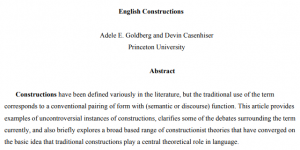PDF #125 – Adele E Goldberg and Devin Casenhiser – English Constructions

Constructions have been defined variously in the literature, but the traditional use of the term corresponds to a conventional pairing of form with (semantic or discourse) function. This article provides examples of uncontroversial instances of constructions, clarifies some of the debates surrounding the term currently, and also briefly explores a broad based range of constructionist theories that have converged on the basic idea that traditional constructions play a central theoretical role in language.
It was the Roman orator, Cicero, who in the first Century BCE, provided our first known application of the word constructio (from which English derives the word ‘construction’) to a grouping of words. Half a century later, Priscian (c. 500 CE), began using the word constructio as a grammatical term, and the
Medieval Linguists known as the Modistae (12th Century) spent much of their time considering the nature of the construction itself. Their work centered on defining the construction as ‘an ordering of words that agree and express a complete meaning.’ Their basic criterion for a construction was that it consisted of at least two words in which one of the words was said to ‘govern’ or ‘require’ the other word or words. This notion of construction must be both grammatically well-formed and express a meaningful sentiment. The crowd run, would have been rejected on syntactic grounds (subject-verb agreement), and Colorless green ideas sleep furiously would have been rejected as a construction on the grounds that it is semantically vacuous. In short, the Modistae believed that constructions were not defined simply on the basis of form (i.e., syntax), but also on function (i.e., semantics)
After reading “Goldberg Casenhiser English Constructions” you can check important issues for ESL teachers on the section PDFs and visit my channel by Youtube.
